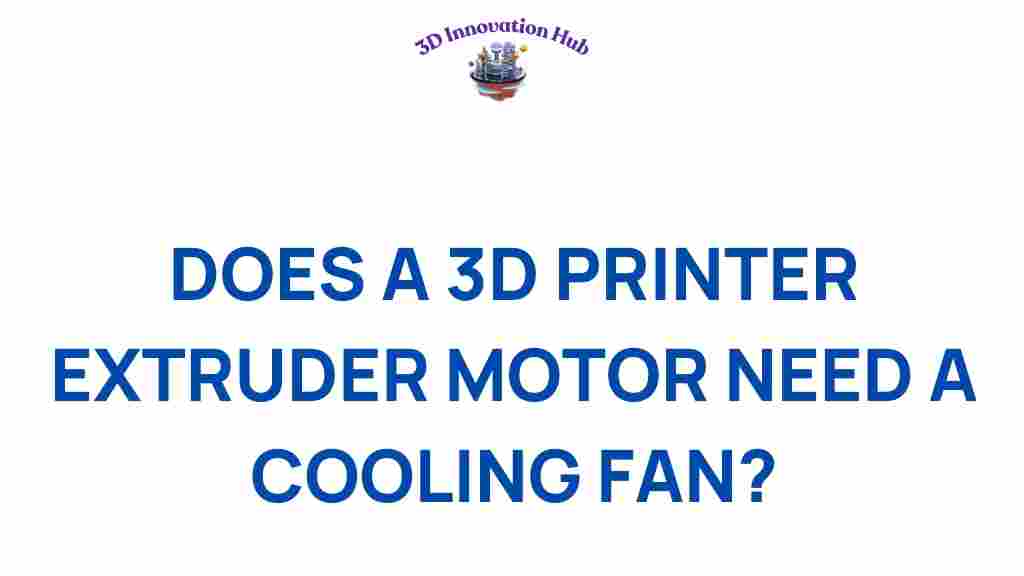The Essential Role of Cooling Fans in 3D Printer Extruder Motors
When it comes to 3D printing, one of the most critical components that ensure smooth operation and high-quality output is the cooling fan associated with the extruder motor. The 3D printer extruder motor is responsible for melting and extruding filament, and without adequate cooling, it can quickly overheat, leading to performance issues and reduced printing quality. In this article, we will explore the essential role of cooling fans in 3D printer extruder motors, focusing on their impact on overheating, performance, maintenance, and the technology behind them.
Understanding the Basics: 3D Printer and Extruder Motor
Before diving into the specifics of cooling fans, it’s crucial to understand the components involved in 3D printing:
- 3D Printer: A machine that creates three-dimensional objects from a digital file by laying down successive layers of material.
- Extruder Motor: The part of the 3D printer that drives the filament into the hot end, where it is melted and deposited onto the print bed.
- Cooling Fan: A fan that helps dissipate heat generated by the extruder motor and the hot end, preventing overheating.
The Importance of Cooling in 3D Printing
Cooling in 3D printing is vital for several reasons:
- Prevents overheating of the extruder motor, which can lead to component failure.
- Improves the overall performance of the 3D printer by maintaining optimal temperatures.
- Enhances the printing quality by ensuring that the filament is extruded smoothly and evenly.
How Cooling Fans Prevent Overheating
Overheating is one of the most common issues faced by 3D printers, particularly during long print jobs. Here’s how cooling fans play a crucial role in preventing this:
1. Heat Dissipation
The extruder motor generates a significant amount of heat during operation. If this heat is not dissipated effectively, it can lead to overheating, which can damage the motor and other components. Cooling fans help to:
- Circulate air around the hot end and extruder motor.
- Lower the temperature by moving hot air away from critical components.
2. Maintaining Optimal Temperature
Every filament material has a specific temperature range for optimal extrusion. Cooling fans help maintain these temperatures, ensuring that:
- The filament melts correctly without being too hot or too cold.
- There is minimal risk of clogs in the hot end.
3. Enhancing Performance
With effective cooling, the extruder motor can perform at its best. This leads to:
- Faster print times due to consistent extrusion.
- Less downtime for maintenance related to overheating issues.
Cooling Fan Technology: Types and Features
Cooling fans come in various designs and specifications. Understanding these can help you choose the right one for your 3D printer:
1. Axial Fans
These are the most common type of cooling fans used in 3D printers. They work by pushing air parallel to the fan’s axis, effectively cooling the extruder motor and hot end. Key features include:
- High airflow rates.
- Compact size, making them suitable for smaller printers.
2. Blower Fans
Blower fans are designed to move air in a specific direction, which can be beneficial for cooling targeted areas. They are often used in:
- Cooling the print itself during the extrusion process.
- Directing airflow precisely to the hot end.
3. Noctua Fans
Noctua fans are known for their quiet operation and efficiency. They are suitable for users who want a low-noise printing experience. Some benefits include:
- Long lifespan.
- Low power consumption.
Step-by-Step Process for Maintaining Cooling Fans
Proper maintenance of cooling fans is essential for ensuring optimal performance of the 3D printer’s extruder motor. Follow these steps for effective maintenance:
1. Regular Inspection
Inspect the cooling fan regularly for dust and debris. A clean fan operates more efficiently and cools better.
2. Cleaning the Fan
To clean the fan, follow these steps:
- Turn off the 3D printer and unplug it.
- Use compressed air to blow out dust from the fan blades and surrounding areas.
- Wipe the exterior with a soft cloth.
3. Checking for Noise
If the fan is making unusual noises, it could indicate a problem. Check for:
- Loose screws or mounting.
- Worn bearings that may need replacement.
4. Testing Fan Operation
Periodically test the fan by powering on the printer and ensuring it runs smoothly without obstruction.
Troubleshooting Cooling Fan Issues
If you encounter issues with your cooling fan, here are some troubleshooting tips:
1. Fan Not Spinning
If the fan is not spinning, check the following:
- Ensure the fan is connected properly to the 3D printer’s control board.
- Inspect for any blockages that may prevent the blades from turning.
2. Overheating Extruder Motor
If the extruder motor is overheating despite the cooling fan running, consider:
- Checking if the fan is functioning correctly and blowing air.
- Ensuring that the ambient temperature is not excessively high.
3. Unusual Noises
If the fan produces strange noises, it may need lubrication or replacement. Look for:
- Dust buildup that can be removed.
- Signs of wear on the fan blades or motor.
Conclusion: Maximizing 3D Printer Performance with Cooling Fans
In conclusion, the role of cooling fans in 3D printer extruder motors is essential for preventing overheating and maintaining high performance. By ensuring proper cooling, you can improve printing quality, reduce maintenance needs, and extend the lifespan of your 3D printer’s components. Regular inspection, cleaning, and troubleshooting of your cooling fan will go a long way in achieving optimal results in your 3D printing endeavors. For further reading on maintaining your 3D printer, check out this comprehensive guide. Remember, investing time in understanding and maintaining your cooling systems can dramatically enhance your 3D printing experience!
For more information on 3D printing technology, visit this resource.
This article is in the category and created by 3D Innovation Hub Team
